
Hammer, axe & chisel in PROFI quality
No household or tradesman can do without a hammer. Each trade has specific requirements for the impact tool. With our hammers and axes in PROFI quality, we offer a variety of head shapes, weights and handle designs, so that the right hammer is available for every need at favourable prices. We also offer chisels at favourable prices.
- We offer hammers in various designs and head weights
- Our hammers and hatchets are available with fibreglass or solid wood handles
- The tools are always manufactured in accordance with applicable DIN standards
- We attach great importance to high quality for maximum customer satisfaction
Locksmiths hammer with wooden handle (various sizes)
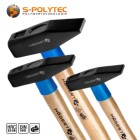 from €6.90 /
from €6.90 /Incl. 19% Tax
Rubber mallet with wooden handle 450g (two-coloured)
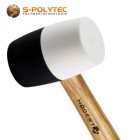 €7.90 / pcs
€7.90 / pcsIncl. 19% Tax
Locksmith's hammer with fibreglass handle (various sizes)
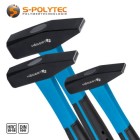 from €10.90 / pcs
from €10.90 / pcsIncl. 19% Tax
Rubber mallet with fibreglass handle 680g (two-coloured)
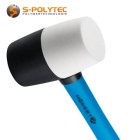 €12.90 / pcs
€12.90 / pcsIncl. 19% Tax
Mallet with fibreglass handle 1000g
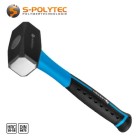 €13.90 / pcs
€13.90 / pcsIncl. 19% Tax
Claw hammer with fibreglass handle 450g
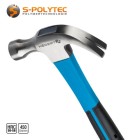 €12.90 / pcs
€12.90 / pcsIncl. 19% Tax
Lat hammer with fibreglass handle 600g
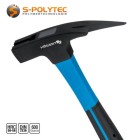 €12.90 / pcs
€12.90 / pcsIncl. 19% Tax
19mm flat chisel with hand guard
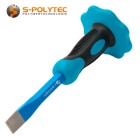 €7.90 / pcs
€7.90 / pcsIncl. 19% Tax
Our hammers are awesome – we promise!
From locksmith's hammers to mallets – uncompromising quality!
Admittedly, hammers are available at any local hardware store. But this is where the wheat is separated from the chaff, because not every hammer delivers what it promises. A hammer is more than just a striking tool for driving nails into walls. Hammers are true all-rounders for rough to very delicate material processing and have to withstand a lot. The tremendous energy of the blow, which ends abruptly as soon as the hammer hits its target – various mis-hits, which are part and parcel of hammering, harsh conditions such as construction dust, moisture and heat – a hammer has to withstand all of this. Always! Otherwise, it can literally hit you in the eye – for example, because the hammer head detaches from the handle during a powerful blow. This is where professional quality pays off.
Why you are well advised to choose a hammer from S-Polytec?
All of our hammers are designed for professional use by tradespeople on construction sites – top brand quality at fair prices. High-quality ash wood or technically advanced handles with a fibreglass core and plastic coating for particularlygentle work on joints and muscles, combined with forged C45 steel that is extra hardened in areas subject to particular stress. This speaks for uncompromising quality and maximum service life that will more than satisfy even the most demanding users. Tools for professionals and doers.
Instead of offering countless locksmith hammers in different qualitygrades and price categories, we focus on a carefully selected range of high-quality products. But that does not mean you have to compromise on variety. We have the right hammer for every purpose. From small locksmith's hammers with a 300-gram head weight to heavy 1-kilogram sledgehammers with short fibreglass handles. If you are looking for a hammer for specific trades such as carpentry or furniture making, you will also find what you need here.
- The hammer heads are made of high-quality, precisely forged C45 steel
- All hammer heads are manufactured in accordance with the applicable DIN standard
- Our locksmith hammers are available in the most common sizes from 300g to 1kg
- The striking surfaces, fins and claws are specially hardened for maximum service life
- The hammer handles are made of solid ash wood or modern fibreglass
- The wooden handles are protected as effectively as possible with a waterproof UV protective coating
- Handle protection sleeves effectively protect wooden handles from damage caused by mis-hits
- The lightweight fibreglass shafts absorb shock energy and protect the wrist
- The rubber mallet with a white, non-abrasive side is ideal for furniture and tiles
- All hammers are approved for commercial use on construction sites
From the Stone Age to the modern hammer
The hammer is one of the oldest tools known to mankind. The first hand axes made from worked stone appeared around 1.75 million years ago, enabling early humans to crack bones and work wood. Around 30,000 years ago, the addition of a steering handlegave rise to the first form of the long hammer – a true precursor to our modern hammers. In the Bronze Age (from around 3000 BC), when humans acquired the knowledge to work metals, bronze and later iron hammer heads replaced stone, improving durability, efficiency and precision. In the Middle Ages, blacksmiths, carpenters, craftsmen and stonemasons specialised in the shape and size of their hammers – from fine jewellery or leather hammers to heavy forging hammers for the production of armour and swords.
The basic shape of the hammer has hardly changed to this day. The hammer consists of a head and a handle. However, over the years, agreat deal has changed in terms of materials, ergonomics and specific head shapes for a wide variety of applications and crafts. And development continues to advance today – making working with a hammer more comfortable, efficient and easier.
Main materials of a modern hammer
- Tool steel High hardness and durability – ideal for construction, carpentry and metalworking hammers
- Soft metal Prevents sparking and damaged surfaces – ideal forgentle metalworking
- Plastic Gentle on sensitive materials, e.g. in furniture manufacturing or stone processing and laying
- Wood Good for precise,gentle work on softer materials, e.g. in carving or stucco work
- Rubber Particularlygentle – perfect for highly scratch-sensitive materials and painted surfaces
Handle materials and their properties
- Solid wood Robust and inexpensive, but less flexible –good for light head weights
- Ash / Hickory Traditional, vibration-damping, durable, hard and extremely robust
- Glass fibre reinforced Weather-resistant, stable, vibration-damping, lightweight
- Metal (usually steel) Very durable, often with plastic coating for vibration damping
- Solid wood Robust and inexpensive, but less flexible –good for light head weights
- Ash / Hickory Traditional, vibration-damping, durable, hard and extremely robust
- Glass fibre reinforced Weather-resistant, stable, vibration-damping, lightweight
- Metal (usually steel) Very durable, often with plastic coating for vibration damping
CONCLUSION:
The hammer – from stone in the Palaeolithic Age to today's high-tech striking tool – remains an essential companion in the craft trade. The variety of shapes, materials and functions enables tailor-made solutions for every task. The material used to make the head depends largely on the materials to be worked with the hammer – from robust steel for heavy blows and hard materials to soft rubber for extremely sensitive surfaces. The material also plays a decisive role in the hammer handle – especially in terms of durability, weather resistance and ergonomics. And because quality is an important aspect for us, we rely exclusively on high-quality steels, ash wood or fibreglass in our selection.
The right hammer for the right purpose
Hammers are available in every price range and in countless designs, ranging from the shape and weight of the head to the material used to make the head and handle. However, not every material is equally suitable for all applications. It is therefore wise to take a close look at the main tasks to be performed with the hammer, as well as the frequency with which the hammer is to be used. Ultimately, quality pays off and is reflected in durability, efficiency and fatigue-free work. We may not offer every type of hammer in the world, but we do offer the most important types and most common sizes made from the highest quality materials for everyday professional use – as is customary at S-Polytec, manufactured in professional quality in accordance with DIN standards and approved for commercial use.
The locksmith's hammer
The versatile classic: square blade, wedge-shaped, rounded at the front, balanced weight distribution and a long handle, just like everyone knows and almost everyone has used before. Ideal for nailing, shaping sheet metal or checking workpieces. Available from us in weight classes from 300g to 1kg, our machinist's hammers enable fine or powerful blows. Optionally with a handle made of solid ash wood or fibreglass, but always with a forged steel head with extra hardened fin and striking surface. Our machinist's hammers comply with DIN 1041.
The claw hammer
A claw hammer is a versatile hand tool that is mainly used in construction and DIY. It consists of a hammer head with two different sides: a flat, usually round striking surface for driving in nails and a curved claw with a split fin, which is used to pull out nails. The handle, made of 2K fibreglass, ensures a securegrip andgood power transmission. The claw hammer combines efficiency with ease of use, making it a universal tool for many indoor and outdoor craft projects.
The carpenter's hammer or roofing hammer
The carpenter's hammer – not just ideal for carpenters. A carpenter's hammer is a special hand tool that is mainly used in timber construction. It is characterised by its asymmetrical shape with a pointed, straight claw, which allows nails to be pulled out precisely, and by a magnetic nail holder on the top. The fibreglass handle significantly dampens the hard blows required to drive in large nails. Carpenters use the hammer not only for nailing, but also for levering, aligning and adjusting beams and slats in wooden structures. The 450g head complies with DIN 7239.
The mallet
The little one for heavy-duty work: A heavy head and two square striking surfaces are the hallmarks of a sledgehammer. A short handle – in our case made of vibration-damping fibreglass with a non-slip, rubberisedgrip – provides optimum control for very powerful blows. Of course, our sledgehammer with its forged steel head complies with DIN 6475. Hardened striking surfaces contribute to enormous wear resistance, even when thingsget tough and the hammer is struck with full force against chisels or rock.
The sledgehammer
When a mallet is no longer sufficient, a large sledgehammer with maximum destructive force is required. It is available with two striking surfaces or with a head that is visually very similar to a locksmith's hammer but significantly heavier. There are also various options for the handle. From short, like a mallet, to very long handles for two-handed use for a long swing and maximum force, no wall can withstand the impact of a sledgehammer in the long run.
Sledgehammer and rubber mallet
The softies among hammers:gentle head materials prevent damage to sensitive surfaces – especially soft wood materials, thin sheet metal or painted surfaces. Rubber hammers or plastic soft hammers are suitable for assembly work, furniture construction, paving and bodywork. Special abrasion-resistant rubber compounds also prevent black rubber abrasion on surfaces.
Safe handling and ergonomic working
Working with a hammer is not without its risks. Apart from the fact that you can miss your target, striking a hard surface with a hammer is exhausting in the long run. Especially if you are not used to such activities. The uneven weight of the hammer and the kinetic energy required demand muscle power. The heavier the hammer, the more strenuous the work. It is not without reason that the handle of agood hammer, regardless of the material it is made of, is ergonomically shaped and matched in length, diameter and weight to the shape and weight of the head. This serves to improve coordination when striking, as well as providing a securegrip and, last but not least, stability. A head weight of 800grams results in higher striking energy than a small 300-gram head. Itgoes without saying that the handle of a heavier hammer is thicker and slightly longer. However, this also has the disadvantage that smaller hands cannot alwaysgrip a large hammer handle securely.
Anyone who has to work regularly or for long periods with a hammer should take a closer look at hammers with fibreglass handles. Although these are a little more expensive than comparable products with wooden handles, the investment pays off. The vibration-damping elements in fibreglass handles reduce muscle fatigue and thus prevent sore muscles. The cross holes in the handle absorb the impact energy and thus protect the wrists. A non-slip handle with soft rubber coating ensures a securegrip, even with sweaty or dusty hands.
The right hammer makes all the difference
Safe handling not only affects muscles and joints. The material for which a hammer is needed can also benefit from choosing the right hammer. It is not the best idea to assemble furniture with high-gloss surfaces using a mallet. Scratches, dents and breaks areguaranteed. Even a soft-faced hammer that is too heavy can leave marks on sensitive or softer surfaces, so the weight of the head also plays an important role. When hammering nails, the right hammer can make the difference between success and failure. Small nails, which are typically used to nail cabinet backs, require a lower head weight so that the nail does not bend on the first strike. Large nails for connecting roof beams or nailing roof battens can certainly be driven into the wood with a light hammer, but it takes what feels like an eternity. A higher head weight can significantly reduce the number of blows required. It does not have to be a 1-kilogram sledgehammer.
- Precision assembly work Sledgehammer or small locksmith's hammer up to 300g
- Hammer in nails Hammer or claw hammer between 300g and 500g
- Remove nails Claw hammer or carpenter's hammer
- Carpentry work Carpentry hammer or roofing hammer between 500g and 800g
- Furniture assembly Sculpting tool with soft, abrasion-resistant rubber coating
- Paving work Heavy rubber mallet or hammer with rubber attachment
- Chiselling work with a chisel Heavy locksmith's hammer or mallet between 1kg and 1.5kg
- Demolition work Heavy mallet or sledgehammer weighing 3kg or more
CONCLUSION:
To work efficiently andgently – both on the material and your own body – it is important to choose the right hammer. Agood quality hammer head and handle not only increase the service life, but also improve handling. An ergonomic handle shape and a well-balanced head position are further factors that increase the safety of working with a hammer.
Tips for safe handling of hammers
- Before use, check that the hammer head is firmly attached to the handle and does not wobble
- Before use, check the hammer handle for splinters, damage or cracks
- Grasp the handle in the lower third near thegrip and hold it firmly while striking
- Swing with strong movements of the arm and shoulder – this movement protects the wrist
- A central impact with the striking surface on the nail or chisel reduces kickback
- Safetygoggles should be worn at all times, especially when working with stone
- When chiselling with a hand chisel, a chisel with hand protection protects against misfires
Care and storage of hammers
Due to the selected materials, there is not much to consider when it comes to hammers, regardless of the type. Occasional cleaning with a damp cloth and scraping off coarse dirt is sufficient. The rubberised handles of fibreglass hammers have holes that provide additional shock absorption. Over time, these can become clogged with dust and dirt, which obviously has a negative effect on the shock-absorbing function. However, if you clean them with a toothpick from time to time, they will continue to begentle on your wrists.
The robust striking tools are also very easy to store. Hammers with fibreglass handles even have a practical hole at the end of the handle for hanging them on the workshop wall. However, hammers with ash wood handles should not be stored permanently in damp environments. Although the handle is coated with a protective varnish, this can wear off over time and allow moisture to penetrate the wood.